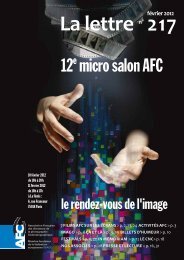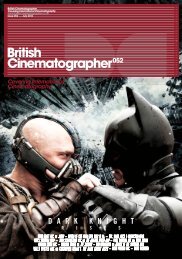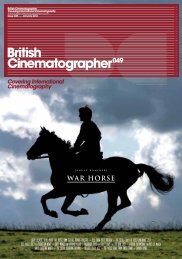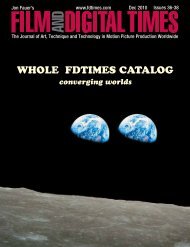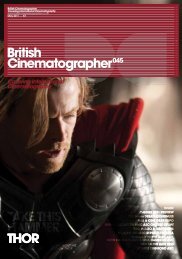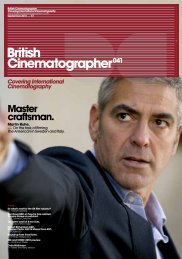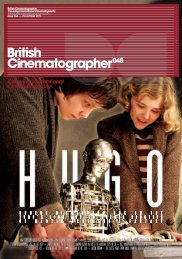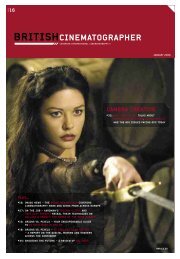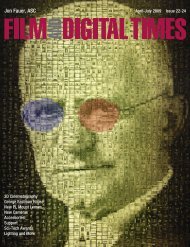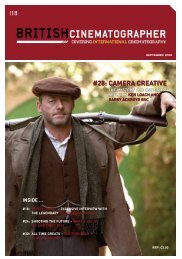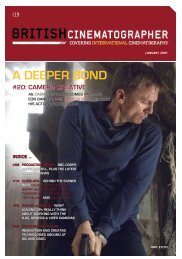British Cinematographer issue 51 - Imago
British Cinematographer issue 51 - Imago
British Cinematographer issue 51 - Imago
Create successful ePaper yourself
Turn your PDF publications into a flip-book with our unique Google optimized e-Paper software.
<strong>British</strong> <strong>Cinematographer</strong><br />
Covering International Cinematography<br />
www.britishcinematographer.co.uk<br />
Issue 0<strong>51</strong> ––– May 2012 46<br />
Codec support includes Avid DNxHD and DNx444,<br />
Avid Meridien JFIF; Apple ProRes 4444; and CineForm<br />
and uncompressed 444 (10-bit) or 422 (8- or 10-bit). It is<br />
slated for availability in July, starting at $43,390.<br />
Codex featured its Onboard S Recorder, developed<br />
for use with compact HD cameras like the Sony PMW-F3<br />
and the Canon EOS C300. Data is recorded onto<br />
Codex’s new capture drives from the HD-SDI output of<br />
the camera. Codex recorders were used recently with<br />
ARRI Alexa cameras by Seamus McGarvey, BSC, ASC on<br />
The Avengers and Caleb Deschanel, ASC on Abraham<br />
Lincoln: Vampire Hunter. <strong>Cinematographer</strong>s currently<br />
using Codex recorders with the Alexa include Roger<br />
Deakins BSC ASC (Skyfall), Bojan Bozelli ASC (The Lone<br />
Ranger), Thomas Newton Siegel ASC (The Seventh Son)<br />
and Chris Menges BSC ASC (Hummingbird).<br />
1 Beyond showed the 1 Beyond Wrangler with<br />
Assimilate Scratch Lab, a portable dailies system that<br />
offers features including real-time playback and review<br />
of media up to 5K resolution. The system is currently<br />
available in two hardware configurations, starting at<br />
$8,995. Assimilate also gave a technology preview of<br />
a new 3D composting function within its Scratch DI<br />
grading system. The company plans to release this new<br />
feature before IBC 2012, and pricing is expected to be<br />
highly competitive.<br />
Bluefish444 is now offering Fluid 4K Review, a<br />
Windows player developed specifically to preview 4K<br />
RGB/YUV files output from Bluefish444 Epoch | Supernova<br />
video cards on 4K capable LCD’s and projectors. The<br />
company said it was developed for cinematographers,<br />
visual effects artists and other professional who want to<br />
preview digital dailies in native 4K resolution.<br />
The upcoming version of Digital Vision’s Nucoda<br />
Film Master—shown at NAB—will include support for<br />
RED Epic HDRx and the Sony F65 4K camera (SRMASTER<br />
format), as well as the ACES (Academy Colour Encoding<br />
Specification) workflow.<br />
3D at NAB<br />
James Cameron and Vince Pace, co-founders and cochairmen<br />
of Cameron | Pace Group, brought 3D to the<br />
Black Magic... surprised almost<br />
everyone with its new, ultra-low<br />
cost 2K camera.<br />
NAB dialogue during a SuperSession.<br />
“The future of 3D is broadcast and we are going to<br />
see explosive grown over the next few years,” Cameron<br />
told the crowd.<br />
Pace introduced more than 10 new products during<br />
the presentation. New technologies aimed at features<br />
and episodic series work include two new integrated<br />
Shadow rigs, one for Red’s Epic and one for ARRI’s new<br />
model Alexa M; and a Mini X-Frame, a modular X-Frame<br />
package. For broadcasting and sports, new technologies<br />
include the Camnet Profile Manager, a centralised ‘5D’<br />
sports production management system; and the Shadow<br />
D handheld rig, which weighs roughly 20 pounds.<br />
Also in the 3D arena, 3Ality Technica (as it was<br />
rebranded when 3Ality Digital acquired Element Techica<br />
just before IBC 2011) introduced its Helix 3D rig, which<br />
can be used for handheld or studio use for features and<br />
broadcasting, according to senior vp Stephen Pizzo.<br />
3Ality also presented a Sony PMW-F3 accessories kit.<br />
P+S Technik showed a new PS-Micro Rig, a compact<br />
and lightweight 3D mirror rig designed for use with micro<br />
cameras such as the SI-2K. P+S reported that it could be<br />
used remote controlled or manually.<br />
Additional NAB News<br />
The subject of High Frame Rates is getting louder. For<br />
postproduction, SGO featured version 6.5 of its DI system<br />
Mistika, which supports 2D and Stereo 3D at 48 fps and<br />
60 fps. The company worked closely with Park Road Post<br />
Production in Wellington to develop the high frame rate<br />
postproduction system that is currently in use on Peter<br />
Jackson’s The Hobbit, which is being shot at 48 fps using<br />
Red Epics and 3Ality rigs.<br />
With an eye toward The Hobbit and additional HFR<br />
productions, projector makers such as Christie were<br />
demonstrating HFR projection at their NAB stands.<br />
Assimilate has also broken new ground with highframe<br />
rates, with Scratch and Scratch Lab supporting<br />
Sony F65 at 48fps, and RED Epic 3D stereo at 48fps.<br />
Just prior to the start of NAB, Cooke reported that<br />
it has “significantly expanded” its workforce of skilled<br />
assembly technicians since 2011 in response to the<br />
47<br />
increasing demand for PL glass. “As digital cameras with<br />
PL mounts, such as the Alexa, RED and Sony F65, have<br />
grown in popularity, so we have seen demand increase<br />
exponentially for our lenses,” said Les Zellan, chairman<br />
and owner, Cooke Optics. “In order to keep pace with<br />
demand we have expanded our workforce and created<br />
several apprenticeships which, in times of recession, is a<br />
remarkable and gratifying thing to be able to do.”<br />
Thales Angenieux was on hand in Las Vegas with two<br />
new Optimo Zoom Lenses. The Optimo19.5-94mm and<br />
Optimo 28-340mm lenses enable image coverage up to<br />
31.4mm and are developed for S35 film and large format<br />
sensor cameras.<br />
Matthews Studio Equipment introduced Skycrapers, a<br />
new line of lighting stands.<br />
Skyscrapers weigh 110-160 lbs., load at 53” to 58”<br />
and raise up to 137” to 180”. Maximum load tops out at<br />
286 lbs. “This is quite different from other stands, including<br />
our veteran stands,” said Robert Kulesh, vp, sales and<br />
marketing. “And, because each stand is constructed<br />
from square tubing, the chance for rotational torqueing is<br />
eliminated.”<br />
Cine Gear returning<br />
to Los Angeles<br />
A sampling of the production technologies found at NAB<br />
can be examined at Cine Gear Expo, which returns to The<br />
Studios at Paramount in Los Angeles from 1-3 June.<br />
During the event, E.F. (Bob) Nettmann, president of<br />
Nettmann Systems International, will be presented with<br />
Cine Gear’s Technical Lifetime Achievement Award.<br />
Nettmann has received various industry honours. Most<br />
recently, in February Nettmann, along with Michael<br />
Sayovitz, Brad Fritzel and Fred Mille, received Scientific<br />
and Engineering Awards, which are Academy Plaques,<br />
during the Academy of Motion Picture Arts and<br />
Sciences’ Scientific and Technical Awards. They were<br />
recognised for the Stab-C Classic, Super-G and Stab-C<br />
Compact stabilising heads.<br />
The Cine Gear programme will include a masterclass<br />
on lighting. Scheduled presenters include Jacek Laskus,<br />
ASC and Ueli Steiger, ASC.<br />
<strong>British</strong> <strong>Cinematographer</strong><br />
Covering International Cinematography<br />
www.britishcinematographer.co.uk<br />
Issue 0<strong>51</strong> ––– May 2012<br />
Letter from America<br />
–––Steven Poster ASC<br />
H Y P E R –<br />
R E A L I T Y<br />
There’s something remarkable going on in the way our<br />
culture now creates and consumes entertainment and<br />
media. Through a constant overlay of technologies, we<br />
have not only changed our physical surroundings, but<br />
also the way we react to even the most mundane of<br />
everyday events.<br />
A recent, striking example was driving with a car full<br />
of colleagues and friends, on our way to a restaurant in<br />
another city. We all knew the address of the restaurant,<br />
but not the exact location. As I looked up from the map<br />
on my Smartphone display, I laughed to see everyone<br />
else in the car with their heads bowed in silence, carefully<br />
tracking our progress on their iPhones. (Thankfully, the<br />
driver was using the GPS on the car’s navigation<br />
screen.) The restaurant could have been across<br />
the street but, of course, we never would have<br />
arrived until Google Maps told us that was so.<br />
Another revelation came to me while<br />
watching this years Oscar telecast (no, I don’t<br />
go every year). After seeing ‘follow us @’ flashed<br />
on our screens a number of times I realized that<br />
those of us who only had the telly on were missing<br />
half of the entertainment value because we<br />
weren’t connected to the technological overlays that<br />
were being offered simultaneously, not to mention the<br />
advertising targeted to those who were experiencing the<br />
entire ball of wax.<br />
Those kinds of technological overlay are now<br />
commonplace, and have created a total cultural<br />
shift in how our American Camera Union, Local 600,<br />
International <strong>Cinematographer</strong>s Guild trains its members<br />
to succeed and thrive in the motion picture, television<br />
and commercial industries. The most obvious result of this<br />
overlay is how many people are involved in the creation<br />
of the visual image – on set or on location - and how we,<br />
as a Guild, must service a shoot in ways we have never<br />
had to before.<br />
A clear example are the many video monitors now<br />
prevalent on set, all of which must be carefully calibrated<br />
to render a close, if not near-perfect, approximation of<br />
what the captured image is going to look like. Whatever<br />
the director, production designer, producer, actors, ADs,<br />
and others see on those monitors indelibly colors the<br />
creative process in ways both large and small. Imagine a<br />
post-production team being saddled with imagery that<br />
bears no true resemblance to the director’s vision because<br />
production’s HD monitors were not tweaked by capable<br />
Union craftspeople, or worse, not calibrated at all.<br />
I had an embarrassing situation at a Hollywood Post<br />
Alliance monitor symposium last year, where the best<br />
and brightest of our technology world were gathered to<br />
Steven Poster ASC says the<br />
bigger and more complex a<br />
system gets the more potential<br />
there is for things to go wrong.<br />
discuss the future of image display. I was asked to set up<br />
a little scene and light it so that we could display a live<br />
image on all of the monitors in the room. I carefully lit and<br />
color corrected the image using a popular on-set color<br />
management system. I walked away satisfied that we had<br />
done a good job providing a feed for the other monitors<br />
in the room. The next morning I came back to the venue<br />
only to see all of the monitors in the room looking horribly<br />
wrong. I admit I went a bit loony trying to figure it out with<br />
dozens of technicians and sales people hanging over my<br />
shoulder offering suggestions. It was a simple solution; the<br />
monitor I was given to color correct with the night before<br />
was never calibrated so that in the morning when the<br />
monitors around the room were connected they all looked<br />
(I was tempted to say something rude) terrible. Even with<br />
all of the experts standing there we still couldn’t get it right<br />
the first time. Imagine if it was your job at stake.<br />
This consistency of image support must flow all the<br />
way through the pipeline for a project to be successful<br />
and accurately reflect creative intent – from the moment<br />
of capture and display all the way down through post<br />
production, previews, and the day things are finalized<br />
for whatever exhibition path may lay ahead. And<br />
technology, terminology, and humanology (don’t try<br />
playing that last one on Words With Friends) have all been<br />
drastically altered to accomplish a new kind of seamless<br />
workflow.<br />
In this world of digital bits (and bytes) our highly<br />
trained technicians play a variety of key roles<br />
that go to the very heart of facilitating this new<br />
paradigm. In rough chronological order they are:<br />
capture, treat, display, record and preserve the<br />
image. These are the different domains of the<br />
camera crew in the era of new digital workflows.<br />
And this technological overlay I’m talking<br />
about has made a century-old process (light<br />
meters, film dailies, lab color timing) that was<br />
once transparent to everyone but the camera<br />
team, visible and accessible to virtually anyone involved<br />
in making a movie.<br />
It is a loud wake-up call for the entire industry to unify,<br />
and work closely in concert – producers adequately filling<br />
and hiring all of the vital on-set crafts, cinematographers<br />
communicating early and often with VFX supervisors and<br />
digital colorists, are just a few examples. And while no one<br />
can predict exactly where this new dawn is taking us, one<br />
thing is certain: the bigger and more complex a system<br />
gets the more potential there is for things to go wrong.<br />
That’s why we need to not only watch each other’s<br />
backs as the ground shifts beneath us, but our front and<br />
sides as well.<br />
Steven Poster ASC<br />
President, International <strong>Cinematographer</strong>s Guild, Local 600



